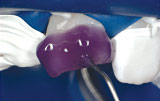Artistic Repair Of Front Teeth With Composite Resin
Taking Tooth Colored Composite Resin Dentistry To The Highest Level Of The Art
(Continued)
|
A Step-by-Step Look At Creating A Composite Resin Restoration |
|
 |
 |
| Step 1: This photo shows a broken edge of a front tooth. | Step 2: A study model was used to create a guide to limit excess and misshaped composite resin material. |
 |
 |
| Step 3: The outer surface of the tooth is roughened to increase bond strength and the aesthetic result. | Step 4: An acid etch solution is applied to the tooth surface to improve bond strength. |
 |
 |
| Step 5: A luting agent is applied to the tooth to increase bond strength. | Step 6: A variety of composite resins are added to the tooth surface to provide depth of color, strength, and shape. |
 |
 |
| Step 7: A light source is used to activate the composite resin. | Step 8: Once the base layer is activated additional composite resin materials are added to build up the tooth's color and shape. |
 |
 |
| Step 9: A liquid composite resin is added to the surface to create a glass-like enamel surface. | Step 10: The restoration is finished and ready for polishing. |
 |
 |
| Before Treatment: This photo shows a broken edge of a front tooth. | After Treatment: The final restoration shows a beautiful result. |
| Photos provided by Dr. Newton Fahl, Jr. | |
Composite Resins And Tooth Art
What follows are the factors that need to be considered when restoring front teeth with direct composite resins.
Assessment and diagnosis of the extent of aesthetic and functional compromise of an upper front tooth or teeth is dependent upon judicious evaluation of the situation before any treatment is recommended. Equipped with such knowledge, the dentist can then undertake the task of developing the unique skills necessary to apply appropriately formulated composites to mimic the aesthetic properties of natural teeth.
Composite resin restorations can cover a range of uses in a range of different hands, with differing results. In order to provide the utmost in aesthetics and longevity with direct composite restorations involves nothing less than artistry — the mastery and perfection of techniques, and the exploration of the options that are in the best interests of the patient. This includes the development of a full understanding of the benefits, limitations, and science behind composite resin materials, properly selecting the right composite resins as well as the techniques for their application, and the production of highly aesthetic restorations that can resist future undesirable effects.
And while the use of direct composite resin enables clinicians to exercise creative control over the restorative process, the successful delivery of aesthetic restorations also requires a deep understanding of natural tooth structure and the elements involved in understanding and replicating tooth color.
The Interwoven Nature Of Tooth Structure And Color
The nature of tooth structure and color are both critical elements to understand so they can be replaced to replicate both natural structure and aesthetics. The color of a tooth is a combination of an inner core, the dentin and an outer shell or covering, the enamel, which make up the “composite” tooth color.
Enamel forms the outer covering of the crown of a tooth, one of the hardest substances produced by animals in nature. Made of very densely packed, regular crystals of calcium (hydroxapatite), it is this crystalline form that provides its hardness, brilliance and translucent properties and its relative resistance to chemical attack. By contrast, the inner core of the tooth and root are made of dentin, which has a more porous and bone-like nature. Dentin has a tubular structure, with microscopic tubes made of a living tissue protein called collagen, onto which calcium crystals are deposited. It is through this living dentin that hot, cold and sensitivity are transmitted through the nerves in the pulp tissue, housed in a central chamber, which sustains the tooth.





